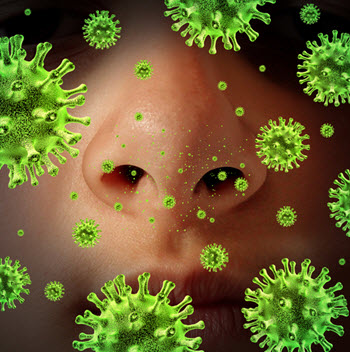The worldwide growth of COVID-19 has likely flipped your regular routine upside down. With most of the country spending most of their time indoors due to Shelter in Place policies, the quality of the air in our homes is more important now than ever. Our home’s air should be fresh and free of dust, mold, pollen, pet dander and other contaminants.
We tend to think of air pollution as something outside — smog, ozone, or haze hanging in the air, especially in summer. But the truth is, the air inside homes, offices, and other buildings can be more polluted than the air outside. The air inside your home may be polluted by lead (in house dust), formaldehyde, fire-retardants, radon, even volatile chemicals from fragrances used in conventional cleaners. Some pollutants are tracked into the home.
Aire-Tech can install indoor air quality products in your residence that can remove bacteria from your air, as well as allergens, odors and volatile organic compounds (VOCs). Not certain which solution is best for your residence? Our knowledgeable technicians can perform an indoor air quality audit. We will test several details that have an influence on your air, including dust levels, VOCs and ventilation. Based on our findings, we can then suggest the most fitting option for your household’s unique needs.
Change Your Air Filters
The air filter in your HVAC system is the front line of defense against poor indoor air quality. A typical central heating and cooling system circulates over 1,000 cubic feet per minute of air through the filter. This means the entire air volume in your house passes through the filter multiple times every day.
A clean filter effectively removes airborne particulates, ranging from dust to invisible microscopic particles. A dirty filter, however, can actually make indoor air quality worse by acting as a reservoir for dirt, dust and other airborne contaminants that are continuously circulated back into your breathing air.
Change the air filter monthly. Instead of cheap, throwaway fiberglass panel filters, choose quality pleated fabric filters rated to trap airborne particles down to a size of 3 microns. When your air filter is clogged, your air handler must work harder to compensate for the blockage of air flow. In addition to driving up your utility bill, the reduced air flow through your heating and cooling system can cause your heat exchanger to overheat and shut off too quickly.
Dehumidifier
Most spores, molds, and bacteria require high levels of moisture to reproduce. A central dehumidification system eliminates excessive summer humidity and reduces the potential health hazards mold poses while improving comfort and lowering energy bills. In addition, repair any minor plumbing leaks, caulk around showers and baths. Seal all tile grout annually. Be certain the floor coverings near moisture sources are watertight. Check for roof, flashing, window, and siding leaks. Grade the flower beds so that rain and irrigation water drains away from the building.
Air Purifier
If you are allergic to indoor allergens and can’t control the source of the problem, it may help to use an air purifier. Placed in the most commonly used areas of the house, these devices, in particular ionic purifiers, can help capture some of the irritants that may trigger your symptoms. You are probably not going to be able to remove these allergens completely, but you can cut down on them, which may help the problem.
Using Ozone for Air Cleaning
Ozone is an important outdoor air pollutant. Higher outdoor air ozone concentrations have been linked to a variety of adverse health effects including respiratory system irritation, asthma, chest pain, and damage to the lungs. Ozone is very chemically reactive, thus, when it is present indoors it reacts with some types of other indoor air pollutants and with some indoor materials such as carpeting. These chemical reactions can produce potentially harmful pollutants including formaldehyde and very small particles. Ozone generators are devices that intentionally produce ozone and release it to the indoor air to chemically destroy some types of other indoor air pollutants.
Ultraviolet Germicidal Lights
Ultraviolet technology is a non-chemical approach to disinfection. In this method of disinfection, nothing is added which makes this process simple, inexpensive and requires very low maintenance. Ultraviolet purifiers utilize germicidal lamps that are designed and calculated to produce a certain dosage of ultraviolet (usually at least 16,000 microwatt seconds per square centimeter but many units actually have a much higher dosage.) The principle of design is based on a product of time and intensity – you must have a certain amount of both for a successful design.
Systems installed in ducts often also irradiate with UV light the wet cooling coils and drain pans present in air conditioning systems. These systems can be very effective in reducing the growth of mold and bacteria on the surfaces of coils and drain pans. The UV germicidal lamp systems must be designed so that occupants receive minimal exposure to the ultraviolet light.
Activated Charcoal Reduces Air Contaminants
Activated carbon has special properties that allow it to remove volatile organic compounds (VOCs), odors, and other gaseous pollutants from the air. It accomplishes this in a way that is different from other air purifiers like HEPA that only filter particle pollution from the air. Carbon air filters trap gas molecules on a bed of charcoal, a process that has a surprisingly colorful history. Here you will dive deep into how they work. Then you can consider if using a carbon air filter will meet your needs by examining its advantages and drawbacks.
Depend on the Experts for Your Indoor Air Quality Requirements
At Aire-Tech, we are dedicated to making your home more comfortable. If your system needs repair or if you would like to upgrade to a more energy efficient system, call us on 951-926-1002. You can also visit our Contact page and complete the contact form.

